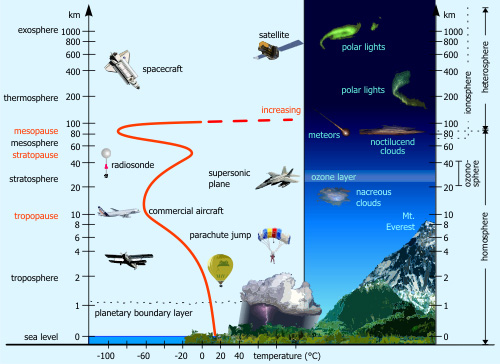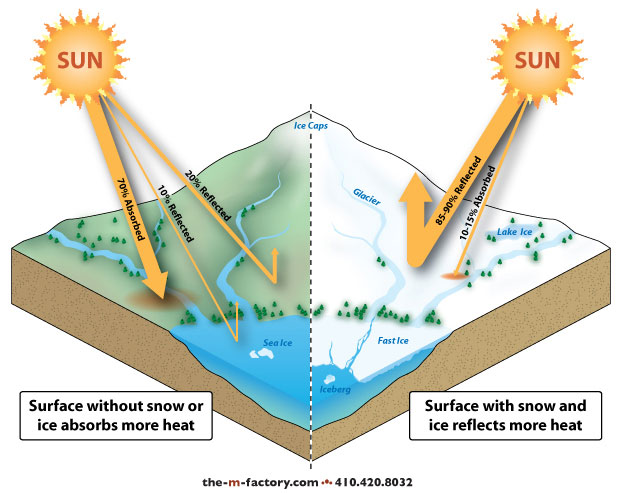-
Chapter 9: CLIMATOLOGY
Introduction
During early life of the earth there was abundance of hydrogen and helium. Extensive volcanism increased nitrogen, sulfur, water vapor, argon and carbon dioxide. Then heavy rains pushed the bulk of CO2 into the oceans. Currently the proportion of gases in the atmosphere is
Nitrogen – 78%
Oxygen – 21%
Argon – 0.93%
Carbon dioxide – 0.03%

Fig 1: Atmosphere
Layers of the Atmosphere:
The atmosphere extends up to 10000 km above the earth’s surface. The parts of the atmosphere are:
Troposphere:
· 90% of atmosphere within 32 km. Tropopause is at 8 km at poles and 18km at equator. At equator cumulonimbus clouds are formed.
Climatic elements like temperature, pressure, humidity, precipitation, clouds lead to variations in local climate and weather phenomenon. The variable water content in the atmosphere leads to great contrast in weather and climate. Without water in the atmosphere there would be no weather or climate
· Temperature decreases with height. It is transparent to shortwave radiation but G.H.G's absorb long wave terrestrial radiation.
· Weather phenomenon is formed at troposphere.
Stratosphere
· Temperature increases with height. Ozone layer is present here and UV radiation is absorbed.
Stratosphere lies above the troposphere and has no dust, smoke or water vapor however seasonal temperature variations are seen.
· Polar stratospheric clouds present. Spy planes, commercial planes and weather balloons fly here.
Mesosphere
· No GHG's and temperature decreases with height. Noctilucent clouds seen.
Meteors burn in this layer.
Thermosphere - Ionosphere
· Gases in ionic state trap insolation. Temperature increases with height.
Ionosphere layer makes short wave radio transmission possible over long distances.
· Largest layer of atmosphere. Useful in radio communication.
· Reflects low frequency and high frequency waves but not very high or ultra high.

Fig 2: Layers of the atmosphere
Heat Budget:
Sun’s energy reaches as solar or radiant energy by process called Insolation. Out of this 35% is reflected back by the dust and the atmosphere, 14% is absorbed by the water vapor in atmosphere and is scattered by dust particles in air this causes “Blue Sky phenomenon”.
The remaining 51% is absorbed by earth’s surface and heats it. The surface the through conduction and convection heats the air above it. Radiation of heat at night by the surface continues during night and since insolation is absent the surface cools.
Land is heated rapidly than water as the heat in water is spread out evenly due to the motion of water. The opaque nature of land means that more heat is absorbed and so land is heated and cooled faster. Transparent nature of water also leads to less heat being absorbed. Specific heat of water is higher so it takes longer to heat. Interiors of continents also face higher temperature variations than coastal areas as the moderating influence of the sea is not seen there.
The differential heating gives rise to land and sea breezes. During day as land gets heated faster than water the air above it is warmer and less dense. The sea remains cool and so a high pressure belt is formed and we experience sea breeze. This is usually stronger in tropics than temperate regions. During night, the land is cooled faster than sea and so a low pressure belt is seen over sea. Winds now move from land to sea and we get land breeze.
Slopes to are affected by temperature as a steep slope is heated faster than gentle slope. Mountains having east west alignment also see their south facing ‘sunny slope’ have a higher temperature than their north facing ‘sheltered slope’. The southern slopes thus see more cultivations and settlements.
Dry soils heat and cool faster than wet soils. The darker soils also better absorbers of heat than lighter soils. The leaves of trees in jungles loose water during day due to evapo-transpiration and this makes the air cooler. The relative humidity increases and mist and fog may form.
Albedo is the percentage of solar radiation reflected by the surface of the solar radiation that is incident. Lower albedo is for dark soil and higher albedo is snowfall.

Fig 3: Albedo
Movement of Air:
Air moves from high pressure area to low pressure area [advection]. When air gets warm it expands as it becomes lighter [convection].
When air is heated it goes up. If it has moisture it condenses and brings rain. However this causes instability. Similarly when air cools it can’t rise it sinks causing high pressure conditions or anti cyclonic conditions on ground.
Temperature inversion:
In hill areas a hot day followed by a cloudless night see the air at a higher altitude cool much faster. This cold, dense air sinks downwards and pushes the warmer air to rise. The temperature at the bottom of the valley is lower than the top. This is called “temperature inversion”. Normally temperature decreases with height but when it increases.
Case 1: On a cool night the air above cools rapidly than the air below. The warm air rises upwards than the colder air. This causes temperature inversion.
Case 2: In a valley the cool air descends downwards and the warm air rises. This cool air causes frost and damages crops.
Effects of temperature inversion:
1. Fog - The water droplets condensed around a dust particle. It reduces visibility and damages crops.
2. Frost
3. Atmospheric Stability – discourages rainfall.
Smog is when water droplet condenses around a pollutant like SO2. It too reduces visibility and is a health hazard. It occurs in cool humid climate.
Photochemical smog: it occurs in warm, dry and sunny climate. It is due to unsaturated hydrocarbons and ozone in presence on sunlight. It is oxidizing smog.

Fig 4: Temperature inversion
Chapter Review
Score more than 80% marks and move ahead else stay back and read again!